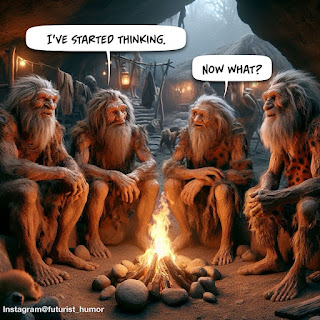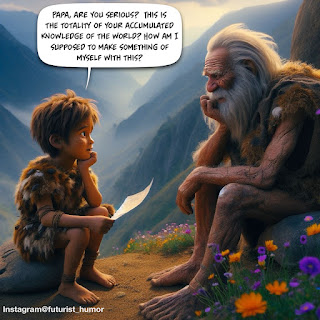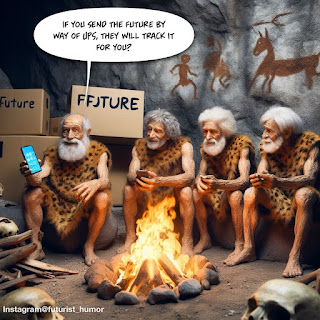Kevin Benedict is a TCS futurist and lecturer focused on the signals and foresight that emerge as society, geopolitics, economies, science, technology, environment, and philosophy converge.
The Evolution and Future of Information Dissemination
Ideation Equals Progress: Navigating the Future through Collective Ingenuity
Using Physics to Understand the Future
"While there can be surprise technological and market disruptions, classical Newtonian mechanical physics’ suggestions that trajectories are the flight paths determined by mass positioning, direction, and momentum as a function of time can help us make accurate predictions." ~ Jeffrey A. Sonnenfeld & Steven Tian
As a writer, I appreciate gifts of inspiration. Reading the above quote set my mind off this morning. It is so true! As a futurist we are always studying trends, innovations and developments, and then searching for signals that will inform us about the "trajectories," each of them will follow. Using Newtonian mechanical physics as helpful metaphors to understand directions and how much inertia a trend has, how fast it is changing, and how much resistance it might face are all useful considerations.
I have had the pleasure over the last year to meet with the leadership teams of many large companies around the world to talk about the future. Bringing a list of over 350 fast evolving trends across the domains of science, technology, societal, geopolitical and economic is a good place to start, but these discussions almost always turn quickly toward Newtonian mechanical physics. How much? How fast? When? What direction? How much inertia? What kind of resistance? These are the right questions!
As I covered in an article earlier this week, we can create different buckets of trends, innovations and developments. Some, are incremental innovations, while others are "launchpad" developments that will support entire new ways of thinking and will change the direction of our future.
It's not enough to pocket a list of quickly evolving trends, developments and technologies. One must understand the physics involved, the dependencies for a development to move forward, understand which rung on the historic ladder of progress a development is sitting, and also understand it's potential for scaling. These, of course, are just the beginning, but they are a good place to start.
Mastering the Art of Decision-Making:Navigating Complexity and Speed in Modern Leadership
The Convergence of Human Bias and AI in Shaping Our Future
A Futurist Pondering Biological vs. Digital Learning
Launchpads and Convergences
- Broad Applicability: Technologies that can be applied across a wide range of industries and disciplines.
- Potential for Disruption: Technologies that challenge or revolutionize the existing way of doing things in significant areas (like communication, energy, transportation).
- Scalability: The potential to be scaled up efficiently and economically to serve large populations.
- Foundation for Further Innovation: A technology that serves as a foundation on which other technologies can be built.
- Addressing Fundamental Needs or Problems: Technologies that solve fundamental human problems or needs (like health, safety, communication).
- Interconnectivity: The ability to connect with and enhance existing technologies or infrastructures.
- Economic Viability: The potential for economic sustainability, profitability and with widespread adoption and development.
- 5G/6G
- Sustainable Energy
- Internet of Things
- Artificial Intelligence
- Drones
- Mixed/Extended/Augmented/Virtual Realities
- Blockchain/Distributed Ledger
- Precision Foods - Farming/Fermentations/Lab Grown/Vertical/Plant Based
- Robotics
- Synthetic Biology
- Genetic Engineering
- Genomics
- Precision Medicine
- Nanotech
- Quantum Computing
Launchpad Technologies
- Broad Applicability: Technologies that can be applied across a wide range of industries and disciplines are more likely to become launchpads.
- Potential for Disruption: Technologies that challenge or revolutionize the existing way of doing things in significant areas (like communication, energy, transportation) have launchpad potential.
- Scalability: The potential to be scaled up efficiently and economically to serve large populations.
- Foundation for Further Innovation: If a technology serves as a foundation on which other technologies can be built, it's a strong candidate.
- Addressing Fundamental Needs or Problems: Technologies that solve fundamental human problems or needs (like health, safety, communication) are likely to be foundational.
- Interconnectivity: The ability to connect with and enhance existing technologies or infrastructures.
- Economic Viability: The potential for economic sustainability and profitability can often drive widespread adoption and development.
- Quantum Computing: Leverages principles of quantum mechanics to process information at unprecedented speeds. It could solve complex problems beyond the reach of classical computers, impacting cryptography, material science, and pharmaceuticals.
- CRISPR and Gene Editing: A technology for editing genomes with high precision. It could be revolutionary in healthcare and agriculture, with the potential to cure genetic diseases and improve crop resilience.
- 5G and Advanced Wireless Technologies: The next generation of wireless communication offering higher speed and lower latency. It could enable a more connected world, crucial for IoT, autonomous vehicles, and smart cities.
- Blockchain and Distributed Ledger Technologies: A decentralized digital ledger technology. It has the potential to transform financial transactions, supply chain management, and data security.
- Artificial Intelligence and Advanced Machine Learning: AI encompasses systems that can learn, reason, and make decisions. Applicable across industries, from healthcare diagnostics to autonomous driving and personalized services.
- Renewable Energy Technologies (like Advanced Solar Cells): Technologies harnessing sustainable energy sources. It's key to addressing climate change and ensuring energy security.
- Augmented Reality (AR) and Virtual Reality (VR): Technologies creating immersive digital experiences. Transformative in gaming, training, education, and remote work.
- Nanotechnology: Manipulating matter at an atomic or molecular scale. It promises breakthroughs in materials science, medicine, and electronics.
- Autonomous Vehicles: Vehicles capable of navigating without human input. It has the potential to revolutionize transportation, logistics, and urban design.
- Biotechnology (including Synthetic Biology): Technology based on biology for industrial and other purposes. It could lead to medical breakthroughs, sustainable manufacturing, and new materials.
- Edge Computing: Distributed computing paradigm bringing data storage and computation closer to data sources. Enhances IoT efficiency, supports AI applications, and reduces latency in computing.
- Advanced Battery Technologies: Innovations in energy storage, such as solid-state batteries. Critical for electric vehicles, renewable energy integration, and portable electronics.
- Internet of Things (IoT): Network of interconnected devices collecting and sharing data. Enabling smart homes, healthcare devices, and industrial automation.
Chain of Development
AI in Supply Chain Management with Expert Joe Carson
Are Humans Part of a Larger Superorganism?
Interviews with Kevin Benedict
-
Futurist David Espindola’s new book has just been released, "Soulful: You in the Future of Artificial Intelligence." Alex Whittin...
-
I had a great time participating in the filming and development of a 10 minute film on digital twins recently. Last week was its premier at...
-
In this deep dive with Munich Re (Groups) cybersecurity expert Bob Parisi, we learn how the insurance and reinsurance industry develops poli...








